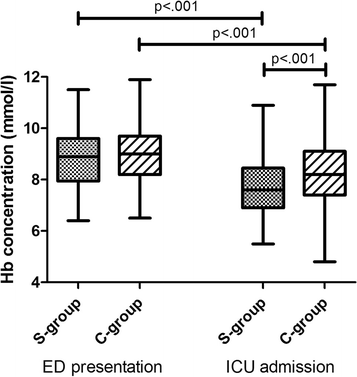'Sepsis-related anemia' is absent at hospital presentation; a retrospective cohort analysis
- PMID: 25947889
- PMCID: PMC4443648
- DOI: 10.1186/s12871-015-0035-7
'Sepsis-related anemia' is absent at hospital presentation; a retrospective cohort analysis
Abstract
Background: Anemia is a common feature during sepsis that occurs due to iatrogenic blood loss, depression of serum iron levels and erythropoietin production, and a decreased lifespan of erythrocytes. However, these mechanisms are unlikely to play a role in anemia at the start of sepsis. Moreover, sequestration of fluids, renal failure and increase of intravascular space may additionally influence the change in hemoglobin concentration during intravenous fluid administration in the acute phase of sepsis.
Methods: In this retrospective study, patients who were admitted acutely to the Intensive Care Unit (ICU) were included. Patients who fulfilled the international criteria for severe sepsis or septic shock were included in the sepsis group (S-group). The remaining patients were allocated to the control group (C-group). Laboratory data from blood samples taken at first presentation to the hospital and at admission to the ICU, the amount of intravenous fluid administration and length of stay in the emergency department were collected and tested for significant differences between groups.
Results: The difference in hemoglobin concentration between the S-group (n = 296) and C-group (n = 320) at first presentation in hospital was not significant (8.8 ± 1.2 versus 8.9 ± 1.2 mmol/l, respectively, p = 0.07). The reduction in hemoglobin concentration from the first presentation at the emergency department to ICU admission was significantly greater in the S-group compared to the C-group (1 [0.5-1.7] versus 0.5 [0.1-1.1] mmol/l, (p < 0.001)). Spearman rho correlation coefficients between the reduction in hemoglobin concentration and the amount of intravenous fluids administered or the creatinine level in the emergency department were significant (0.3 and 0.4, respectively, p < 0.001). In a multivariate regression analysis, creatinine, the amount of fluid administration and the presence of sepsis remained independently associated.
Conclusions: Prior to in-hospital intravenous fluid administration, there is no significant difference in hemoglobin concentration between acute septic patients and acutely ill controls. Within several hours after hospital admission, there is a significant reduction in hemoglobin concentration, not only associated with the amount of intravenous fluids administered and the creatinine level, but also independently with sepsis itself.
Figures

References
MeSH terms
Substances
LinkOut - more resources
Full Text Sources
Other Literature Sources
Medical

